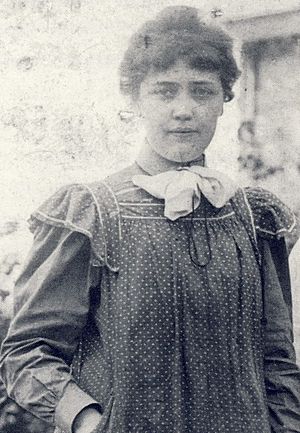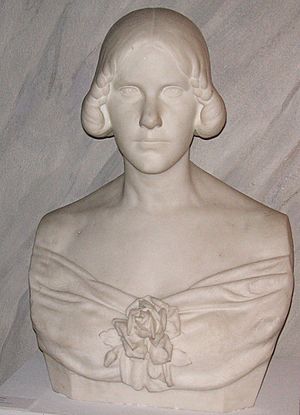Ruth Milles facts for kids
Quick facts for kids
Ruth Milles
|
|
|---|---|

Ruth Milles in the 1890s
|
|
| Born |
Ruth Anna Maria Andersson
April 19, 1873 Vallentuna, Sweden
|
| Died | February 11, 1941 (aged 67) Rome, Italy
|
| Resting place | Protestant Cemetery, Rome |
| Nationality | Swedish |
| Education |
|
| Known for | Figurines |
|
Notable work
|
Marble bust of Jenny Lind |
| Style | Impressionism |
| Movement | Realism |
Ruth Milles (born April 19, 1873 – died February 11, 1941) was a Swedish artist. She was a talented sculptor and writer. Ruth is best known for her small statues, called figurines, and her reliefs, which are sculptures that stick out from a flat surface.
Contents
Ruth Milles: Early Life and Learning
Ruth Anna Maria Andersson was born on April 19, 1873. Her birthplace was Örby Manor in Vallentuna, near Stockholm, Sweden. Her father, August Emil Sebastian Andersson, had an important job in Sweden. Her mother was Walborg Alfhild Maria Tisell.
Ruth had two siblings. Her mother passed away when Ruth was young. Later, her father remarried and she gained three half-siblings. Her brother, Carl Milles, also became a famous sculptor. Her half-brother, Evert Milles, was an architect.
How Ruth Studied Art
Ruth Milles was a very educated artist. She went to the Tekniska Skolan (Technical School) in Stockholm from 1892 to 1893. This school is now known as Konstfack University College of Arts, Crafts and Design.
After that, she studied at the Royal Swedish Academy of Arts from 1894 to 1898. She was so good that she was allowed to skip a year of study! During this time, she also visited the Theosophical Society. This group's ideas influenced her artwork later on.
Ruth Milles: Her Artistic Career
In 1898, Ruth Milles moved to Paris, France. Her brother Carl had moved there about a year before. In Paris, Ruth continued her art studies. She attended the Académie Colarossi and the École des Beaux-Arts. Paris became her home base for trips around France and Germany.
Ruth and Carl spent a lot of time together in Paris. They even started a company to work together on art and business. They sold small bronze figurines. Many of these were statues of children or characters from fairy tales that Ruth created.
Inspiration from France
During the summers, Ruth would visit a fishing village called Briac in Bretagne. She found inspiration there for her sculptures. She loved to draw the local fishers and their daily lives. Her sculptures from this time showed an early Impressionistic style. This style focuses on capturing a moment or impression, often with visible brushstrokes or textures.
While in France, Ruth and Carl decided to change their last name. They chose "Milles" after their father's nickname. In 1902, Ruth received a special award at the famous Salon art show in Paris.
Returning to Sweden and New Art Forms
In 1903, Ruth fell ill. She had to return to Sweden because of her health. She settled in Islinge on Lidingö island. There, she set up her own art studio. Sometimes, she even shared her studio with her brother Carl's wife, Olga Milles.
Ruth received many requests for her art from important places in Stockholm. For example, the Royal Dramatic Theatre asked her to create medallions and busts. These included a bust of the famous singer Jenny Lind and the actor Georg Dahlqvist.
From 1904 to 1916, Ruth's art was shown in many international exhibitions. She won silver medals for her work in St. Louis (1905) and Buenos Aires (1910). Her art was also shown in Rome (1911), at the world's fair in San Francisco (1915), and in Denmark (1916).
However, her health continued to get worse. This made it hard for her to keep sculpting. So, she started to focus on painting instead. After that, she began writing. She also drew pictures for books, both her own stories and those by other writers.
Later Life and Legacy
In 1932, Ruth Milles moved to Rome, Italy. Her health became even more difficult. She passed away in Rome in 1941. She was buried in the Protestant Cemetery, Rome.
Ruth Milles's artwork can be seen in important museums today. These include the Nationalmuseum and the Thiel Gallery in Sweden. There is also a bust and a painting by her in the home of Ellen Key, a famous Swedish writer.
Selected Works by Ruth Milles
Ruth Milles created many beautiful sculptures and wrote several books. Here are some examples of her work:
Sculptures
- Blåsväder ("Windy weather")
- Flitiga Kajsa ("Diligent Kajsa")
- Moder med barn ("Mother and child")
- Flicka med knyte ("Girl with bundle")
- Mjölkflicka ("Milkmaid")
Books
- Dagarnas grå och blommornas blå ("The Grey of the Days and the Blue of the Dreams") – a collection of poems (1918)
- Trollskrattet ("The Laughter of the Troll") – a children's tale (1923)
- Didrik Flygare ("Didrik the Aviator") – a children's tale (1924)
- Glohit och Glodit ("Looky Here and Looky There") – a children's tale (1926)


